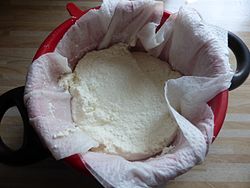Acid-set cheese


Acid-set or sour milk cheese is cheese that has been curdled (coagulated) by natural souring, often from lactic acid bacteria, or by the addition of acid. This type of cheese is technologically simple to produce.[1]
When making soft acid-set cheese using bacteria, the coagulum results from production of lactic acid by the starter microorganisms.[1]
Cheeses can be classified according to a variety of features including ripening characteristics, special processing techniques (such as
Ricotta and most other whey cheeses are made by first heating the milk to between 90 and 92 degrees Celsius to create coprecipitation of casein and whey protein before addition of lactic or citric acid.[2]
Production
Rennet is also sometimes used in the processing of other fresh, soft cheeses like
Ricotta is a high-moisture cheese, like cottage cheese, but it is not a pressed curd cheese. It can be made from
Regional varieties

In Germany the term Sauermilchkäse is usually applied to ripened acid-set cheeses only, but not to fresh cheeses. The various types of ripened sour milk cheese include:
- Handkäse
- Harzer
- Nieheimer
- Olomoucké syrečky(Olmützer Quargel)
- Tyrolean grey cheese
See also
References
- ^ ISBN 9789401115322. Retrieved 23 March 2019.
- ISBN 9783527339907.
- ISBN 9780834212602. Retrieved 23 March 2019.
- ISBN 9780470049648. Retrieved 23 March 2019.
